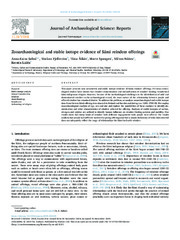Zooarchaeological and stable isotope evidence of Sámi reindeer offerings
Permanent link
https://hdl.handle.net/10037/17361Date
2019-12-19Type
Journal articleTidsskriftartikkel
Peer reviewed
Author
Salmi, Anna-Kaisa; Fjellström, Markus; Äikäs, Tiina; Spangen, Marte; Nunez, Milton; Lidén, KerstinAbstract
This paper presents new osteometric and stable isotope evidence of Sámi reindeer offerings. Previous archaeological studies have shown that reindeer domestication and intensification of reindeer herding transformed Sámi indigenous religion. However, because of the methodological challenges in the identification of wild and domesticated reindeer in the archaeological record, the exact nature of the relationship between people and offered reindeer has remained elusive. To address this problem, we analyze zooarchaeological and stable isotope data from thirteen Sámi offering sites situated in Finland and Sweden and dating to c. 1200–1700 CE. We employ zooarchaeological analysis of age, sex and size and explore the possibilities of these analyses to identify domestication and other characteristics of reindeer selected for offering. Analyses of stable isotopes of carbon, nitrogen and sulphur are utilized to identify human influence on reindeer feeding patterns and mobility. Our results show that many kinds of reindeer with different engagements with people were offered. The results confirm that people had different motives for giving offerings and that a simple dichotomy of wild/domesticated does not adequately reflect the range of relationships the Sámi had with reindeer.
Publisher
ElsevierCitation
Salmi A, Fjellström M, Äikäs T, Spangen MS, Nunez M, Lidén K. Zooarchaeological and stable isotope evidence of Sámi reindeer offerings. Journal of Archaeological Science: Reports. 2019;29:1-17Metadata
Show full item record
Copyright 2019 The Author(s)


 English
English norsk
norsk